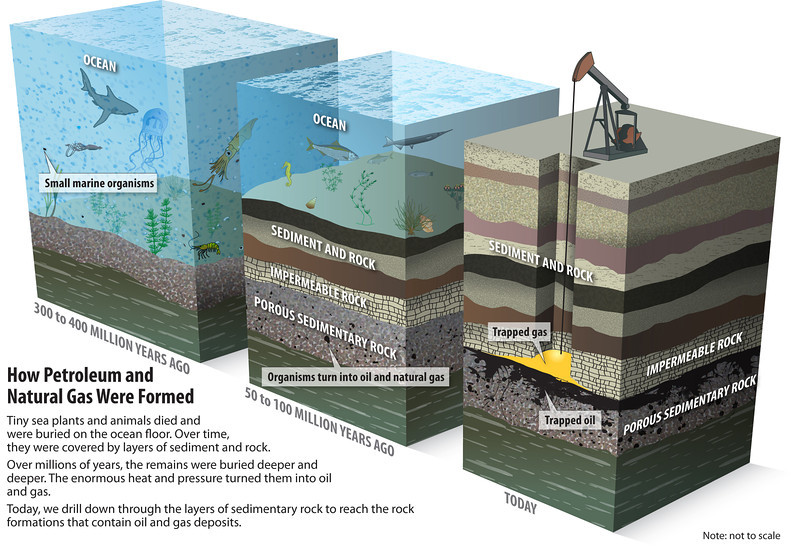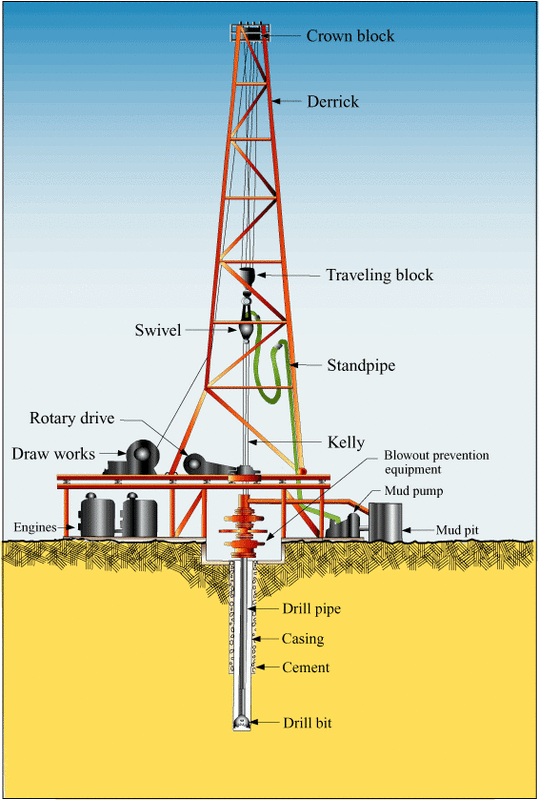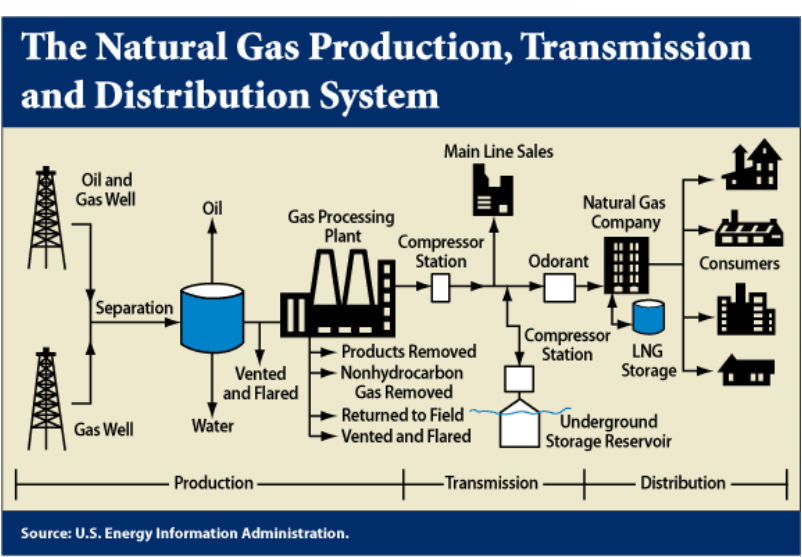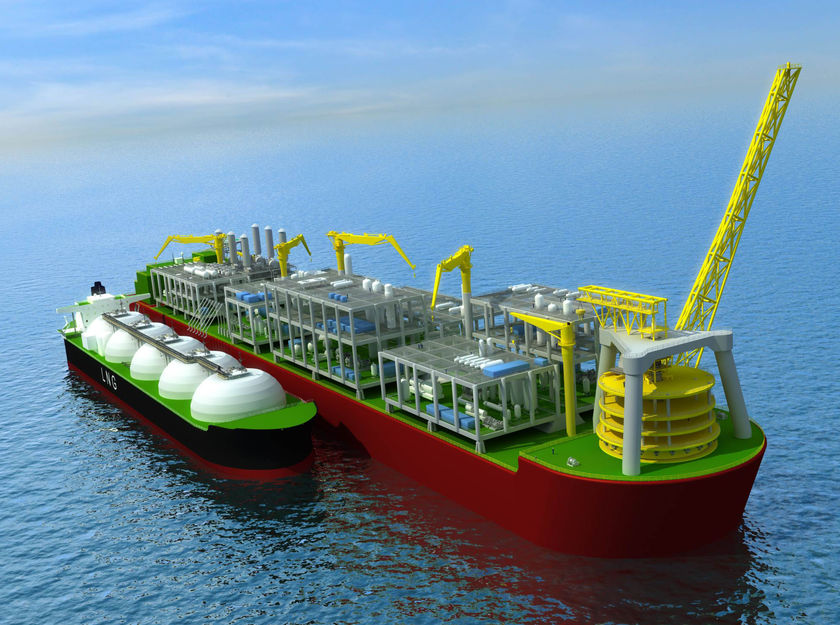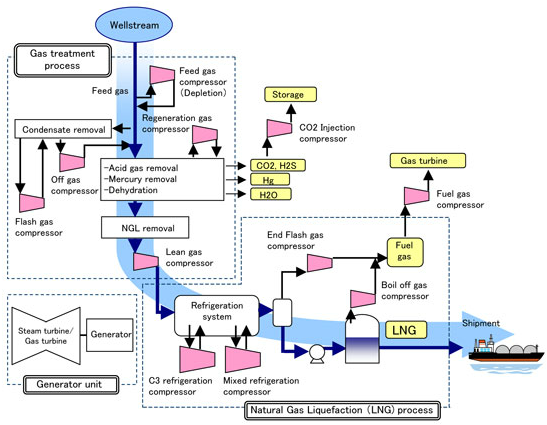How Was Natural Gas Formed?
The main ingredient in natural gas is methane, a gas (or compound) composed of one carbon atom and four hydrogen atoms. Millions of years ago, the remains of plants and animals (diatoms) decayed and built up in thick layers. This decayed matter from plants and animals is called organic material — it was once alive. Over time, the sand and silt changed to rock, covered the organic material, and trapped it beneath the rock. Pressure and heat changed some of this organic material into coal, some into oil (petroleum), and some into natural gas — tiny bubbles of odorless gas.
In some places, gas escapes from small gaps in the rocks into the air; then, if there is enough activation energy from lightning or a fire, it burns. When people first saw the flames, they experimented with them and learned they could use them for heat and light.
In some places, gas escapes from small gaps in the rocks into the air; then, if there is enough activation energy from lightning or a fire, it burns. When people first saw the flames, they experimented with them and learned they could use them for heat and light.
How Do We Get Natural Gas?
The search for natural gas begins with geologists, who study the structure and processes of the Earth. They locate the types of rock that are likely to contain gas and oil deposits.
Today, geologists' tools include seismic surveys that are used to find the right places to drill wells. Seismic surveys use echoes from a vibration source at the Earth’s surface (usually a vibrating pad under a truck built for this purpose) to collect information about the rocks beneath. Sometimes it is necessary to use small amounts of dynamite to provide the vibration that is needed.
Scientists and engineers explore a chosen area by studying rock samples from the earth and taking measurements. If the site seems promising, drilling begins. Some of these areas are on land but many are offshore, deep in the ocean. Once the gas is found, it flows up through the well to the surface of the ground and into large pipelines.
Today, geologists' tools include seismic surveys that are used to find the right places to drill wells. Seismic surveys use echoes from a vibration source at the Earth’s surface (usually a vibrating pad under a truck built for this purpose) to collect information about the rocks beneath. Sometimes it is necessary to use small amounts of dynamite to provide the vibration that is needed.
Scientists and engineers explore a chosen area by studying rock samples from the earth and taking measurements. If the site seems promising, drilling begins. Some of these areas are on land but many are offshore, deep in the ocean. Once the gas is found, it flows up through the well to the surface of the ground and into large pipelines.
|
Some of the gases that are produced along with methane, such as butane and propane (also known as "by-products"), are separated and cleaned at a gas processing plant. The by-products, once removed, are used in a number of ways. For example, propane can be used for cooking on gas grills.
Dry natural gas is also known as consumer-grade natural gas. In addition to natural gas production, the U.S. gas supply is augmented by imports, withdrawals from storage, and by supplemental gaseous fuels. Most of the natural gas consumed in the United States is produced in the United States. Some is imported from Canada and shipped to the United States in pipelines. A small amount of natural gas is shipped to the United States as liquefied natural gas (LNG). We can also use machines called "digesters" that turn today's organic material (plants, animal wastes, etc.) into natural gas. This process replaces waiting for millions of years for the gas to form naturally. |
Getting Natural Gas to Users
Natural gas is often stored before it is delivered. Natural gas is moved by pipelines from the producing fields to consumers. Because natural gas demand is greater in the winter, it is stored along the way in large underground storage systems, such as old oil and gas wells or caverns formed in old salt beds. The gas remains there until it is added back into the pipeline when people begin to use more gas, such as in the winter to heat homes.
When the gas gets to the communities where it will be used (usually through large pipelines), it flows into smaller pipelines called "mains." Very small lines, called "services," connect to the mains and go directly to homes or buildings where it will be used.
When the gas gets to the communities where it will be used (usually through large pipelines), it flows into smaller pipelines called "mains." Very small lines, called "services," connect to the mains and go directly to homes or buildings where it will be used.
Natural gas can also be stored and transported as a liquid
|
When chilled to very cold temperatures, approximately -260°F, natural gas changes into a liquid and can be stored in this form. Because it takes up only 1/600th of the space that it would in its gaseous state, liquefied natural gas (LNG) can be loaded onto tankers (large ships with several domed tanks) and moved across the ocean to other countries. When this LNG is received in the United States, it can be shipped by truck to be held in large chilled tanks close to users or turned back into gas when it's ready to put in the pipelines.
|
What is Liquefied Natural Gas?
Liquefied natural gas (LNG) is natural gas that has been cooled to about -260°F for shipment and/or storage as a liquid. The volume of the liquid is about 600 times smaller than in its gaseous form. In this compact form, natural gas can be shipped in special tankers to receiving terminals in the United States and other importing countries. At these terminals, the LNG is returned to a gaseous form and transported by pipeline to distribution companies, industrial consumers, and power plants.
In 2012 total U.S. natural gas production was equal to 94% of the U.S. natural gas consumption. Net natural gas imports contributed to the remaining consumption volume*.
In 2012, LNG imports contributed about 1% of total natural gas consumption. LNG imports from Egypt, Qatar, Trinidad and Tobago, and Yemen contributed about 96% of total LNG imports.
Even though the United States is primarily an importer of LNG, it is also an exporter. Sometimes LNG originally imported to the United States is "re-exported" to new destinations where prices are higher.
In 2012 total U.S. natural gas production was equal to 94% of the U.S. natural gas consumption. Net natural gas imports contributed to the remaining consumption volume*.
In 2012, LNG imports contributed about 1% of total natural gas consumption. LNG imports from Egypt, Qatar, Trinidad and Tobago, and Yemen contributed about 96% of total LNG imports.
Even though the United States is primarily an importer of LNG, it is also an exporter. Sometimes LNG originally imported to the United States is "re-exported" to new destinations where prices are higher.
Where Our Natural Gas Comes From
Most of the Natural Gas Consumed in the United States Comes from Domestic Production
U.S. natural gas production and consumption were nearly in balance through 1986. After that, consumption began to outpace production, and imports of natural gas rose to meet U.S. demand for the fuel. Production increased from 2006 through 2011, when it reached the highest recorded annual total since 1973. The increases in production were the result of more efficient, cost-effective drilling techniques, notably in the production of natural gas from shale formations.
Share of 2011 natural gas marketed production:
Supplemental Gas Supplies
Supplemental gas supplies include blast furnace gas, refinery gas, propane-air mixtures, and synthetic natural gas (gas made from petroleum hydrocarbons or from coal). These supplemental supplies totaled 60 billion cubic feet (Bcf) in 2011. The largest single source of synthetic gas is the Great Plains Synfuels Plant in Beulah, North Dakota, where coal is converted to pipeline-quality gas.
Natural Gas Is Stored Underground
There were about 410 active underground storage fields (salt fields, aquifers, or depleted fields) in the United States during 2011. Natural gas is injected into these fields primarily during April through October and withdrawn primarily from November through March during the peak heating season. As of April 2012, the estimated capacity for peak working gas storage was 4,239 Billion cubic feet.
U.S. natural gas production and consumption were nearly in balance through 1986. After that, consumption began to outpace production, and imports of natural gas rose to meet U.S. demand for the fuel. Production increased from 2006 through 2011, when it reached the highest recorded annual total since 1973. The increases in production were the result of more efficient, cost-effective drilling techniques, notably in the production of natural gas from shale formations.
Share of 2011 natural gas marketed production:
- Texas (29%)
- Wyoming (9%)
- Federal Offshore Gulf of Mexico (8%)
- Louisiana (13%)
- Oklahoma (8%)
Supplemental Gas Supplies
Supplemental gas supplies include blast furnace gas, refinery gas, propane-air mixtures, and synthetic natural gas (gas made from petroleum hydrocarbons or from coal). These supplemental supplies totaled 60 billion cubic feet (Bcf) in 2011. The largest single source of synthetic gas is the Great Plains Synfuels Plant in Beulah, North Dakota, where coal is converted to pipeline-quality gas.
Natural Gas Is Stored Underground
There were about 410 active underground storage fields (salt fields, aquifers, or depleted fields) in the United States during 2011. Natural gas is injected into these fields primarily during April through October and withdrawn primarily from November through March during the peak heating season. As of April 2012, the estimated capacity for peak working gas storage was 4,239 Billion cubic feet.
Uses of Natural Gas
Natural Gas Is a Major Energy Source for the United States
About 25% of energy used in the United States came from natural gas in 2012. The United States used 25.46 trillion cubic feet (Tcf) of natural gas in 2012.
How Natural Gas Is Used
Natural gas is used to produce steel, glass, paper, clothing, brick, electricity, and as an essential raw material for many common products. Some products that use natural gas as a raw material are: paints, fertilizer, plastics, antifreeze, dyes, photographic film, medicines, and explosives.
Slightly more than half of the homes in the United States use natural gas as their main heating fuel. Natural gas is also used in homes to fuel stoves, water heaters, clothes dryers, and other household appliances.
The major consumers of natural gas in the United States in 2012 (Tcf - Trillion cubic feet):
Where Natural Gas Is Used
Natural gas is used throughout the United States, but the top natural gas consuming states in 2011 were:
About 25% of energy used in the United States came from natural gas in 2012. The United States used 25.46 trillion cubic feet (Tcf) of natural gas in 2012.
How Natural Gas Is Used
Natural gas is used to produce steel, glass, paper, clothing, brick, electricity, and as an essential raw material for many common products. Some products that use natural gas as a raw material are: paints, fertilizer, plastics, antifreeze, dyes, photographic film, medicines, and explosives.
Slightly more than half of the homes in the United States use natural gas as their main heating fuel. Natural gas is also used in homes to fuel stoves, water heaters, clothes dryers, and other household appliances.
The major consumers of natural gas in the United States in 2012 (Tcf - Trillion cubic feet):
- Electric power sector — 9.1 (Tcf)
- Industrial sector —7.1 Tcf
- Residential sector — 4.2 Tcf
- Commercial sector —2.9 Tcf
Where Natural Gas Is Used
Natural gas is used throughout the United States, but the top natural gas consuming states in 2011 were:
- Texas
- California
- Louisiana
- Florida
- New York
- Illinois
| understanding_natural_gas_markets.pdf | |
| File Size: | 1872 kb |
| File Type: | |

